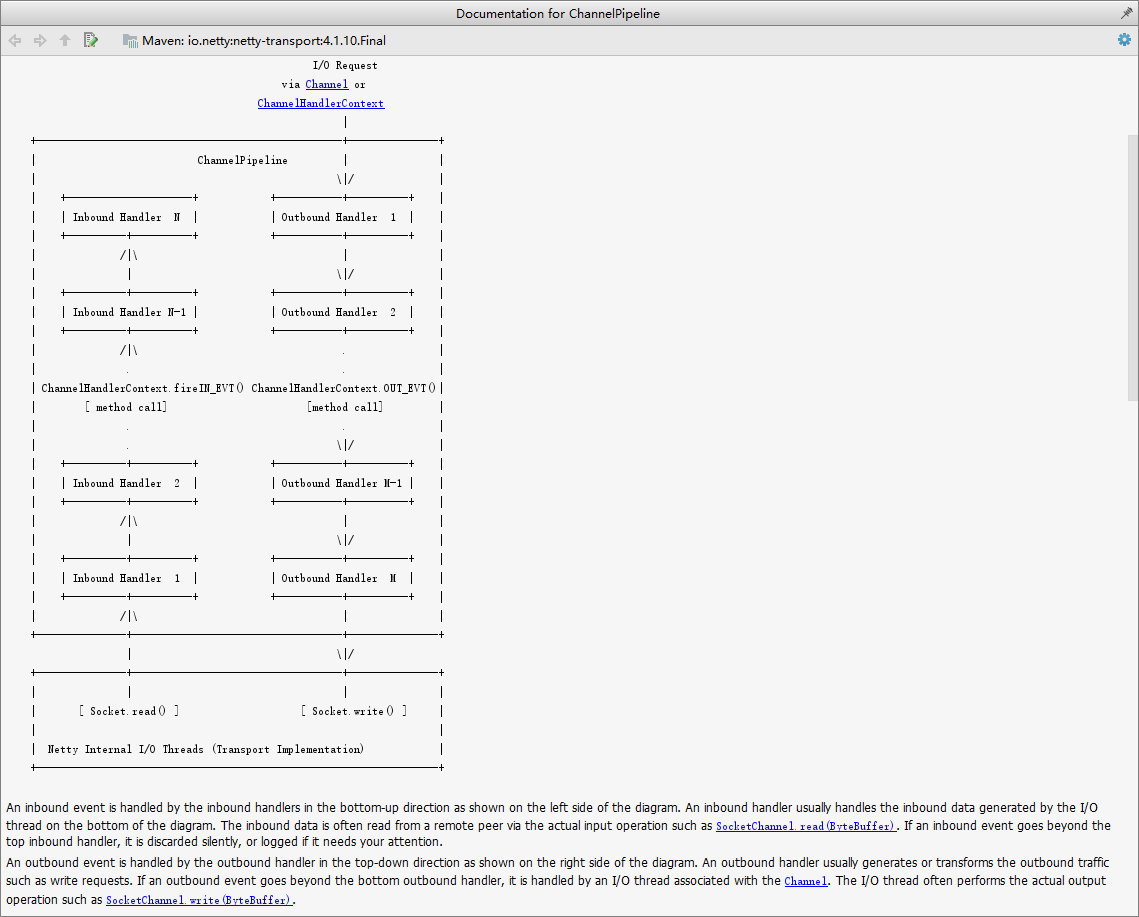netty中的channelPipeline在编程中的作用
在netty编程中我们绝大多数是要是用nio的,nio相比传统的io更加高效,而nio中核心概念离不开channel,buffer,selector三个重要的对象。
那么在netty中有一个channelPipeline的概念,表面理解起来是通道的意思,实际它是在数据传输过程中的通道容器。
之所以定义为通道容器就是因为在这里去注册InboundChannelHandle和OnboundChannelHandle。而且netty中设计更为巧妙的是,数据流入和流出的处理器可以是不对称的,当然也有数据出入时同时经过相同的channelHandle处理器。
一张图描绘出netty的数据入栈出栈是可以完全独立的过滤器:

继续跟踪代码并我们会发现,我们经常编写的代码中总是会出现这样的情况:
.childHandler(new ChannelInitializer<SocketChannel>() { //设置channel中的多个handler @Override protected void initChannel(SocketChannel socketChannel) throws Exception { ChannelPipeline channelPipeline = socketChannel.pipeline(); ByteBuf delimiter = Unpooled.copiedBuffer("$_$".getBytes()); channelPipeline.addLast("delimiterBasedFrameDecoder", new DelimiterBasedFrameDecoder(4096, delimiter)); channelPipeline.addLast("stringDecoder", new StringDecoder(CharsetUtil.UTF_8)); channelPipeline.addLast("stringEncoder", new StringEncoder(CharsetUtil.UTF_8)); channelPipeline.addLast("testServerChannelHandler", new TestServerChannelHandler()); } });
public class TestServerChannelHandler extends SimpleChannelInboundHandler<String> { public static ChannelGroup channelGroup = new DefaultChannelGroup(GlobalEventExecutor.INSTANCE); @Override protected void channelRead0(ChannelHandlerContext channelHandlerContext, String s) throws Exception { Channel channel = channelHandlerContext.channel(); channelGroup.forEach(currChannel -> { if (channel == currChannel) { currChannel.writeAndFlush("[自己]:" + s + TestServer.delimiterStr); } else { currChannel.writeAndFlush("[" + currChannel.remoteAddress().toString() + "]:" + s + TestServer.delimiterStr); } }); }
我们会发现在channelRead0中有个ChannelHandlerContext参数,那我们就说下这个Context到底是个什么东西。
我们在addLast方法添加ChannelHandle的时候会发现,有些是继承了ChannelInboundHandle,而有些是继承了ChannelOutboundHandle,另一些是二者都继承了。那么在addlast方法实际调用内部是这样的:
@Override public final ChannelPipeline addLast(EventExecutorGroup group, String name, ChannelHandler handler) { final AbstractChannelHandlerContext newCtx; synchronized (this) { checkMultiplicity(handler); newCtx = newContext(group, filterName(name, handler), handler);//这里我们实质是创建了一个ChannelHandleContext对象后在调用addLast0方法将上下文对象放入了“事件处理链表”。 addLast0(newCtx); // If the registered is false it means that the channel was not registered on an eventloop yet. // In this case we add the context to the pipeline and add a task that will call // ChannelHandler.handlerAdded(...) once the channel is registered. if (!registered) { newCtx.setAddPending(); callHandlerCallbackLater(newCtx, true); return this; } EventExecutor executor = newCtx.executor(); if (!executor.inEventLoop()) { newCtx.setAddPending(); executor.execute(new Runnable() { @Override public void run() { callHandlerAdded0(newCtx); } }); return this; } } callHandlerAdded0(newCtx); return this; }
这里揭示了一个问题,我们要清清楚,并且可以准确的说:channelPipeline是一个容纳channelHandleContext的容器,而容器的内部又持有当前的channel和channelPipeline对象,这些channelHandleContext实际上是组成了一个链表,在数据进行InBound和OutBound
时候进行相应的处理。我们从addLast0方法可以看出是channelHandleContext的链表。如下
private void addLast0(AbstractChannelHandlerContext newCtx) { AbstractChannelHandlerContext prev = tail.prev; newCtx.prev = prev; newCtx.next = tail; prev.next = newCtx; tail.prev = newCtx; }
这里还有个重点问题,我们在使用netty进行实际开发的时候,通过channel对象能获取到writeAndFlush方法将数据写入并发回给客户端。我们知道netty有一系列的
channelHandle控制数据流入和流出,那么在经过OutBoundHandle数据的时候,如果我们调用channel本身的riteAndFlush方法,数据流出会经过所有的ChannelOutBoundHandle
处理器。而如果调用的writeAndFlush方法来自于ChannelHandleContext则只会调用当前handle接下来的ChannelOutBoundHandle处理器,之前的handle处理则不会经过,那么在
这里我们可以根据当前情景适当的选择调用对象,来提升性能。过程如下图:

性能优化点:
(0)对于关注事件发生的EventLoop,尽量使用一个线程来处理,将更多线程分给实际的业务处理。
(1)尽量减小channelpiplen的长度,可减少EventLoop在处理单个事件时的阻塞时间。
(2)减少ChannelHandler的重复创建,可大大减小内存的开销,但是要注意chennelRead的线程安全
(3)对使用完毕的ByteBuf进行引用计数的清除,可对空间进行回收,而且ByteBuf默认是使用堆外内存创建的,堆外内存创建的数据不会用户态和内核态的数据copy大大减少了时间复杂度。
(4).childOption(ChannelOption.TCP_NODELAY, true)和.option(ChannelOption.TCP_NODELAY, true)禁用nagle算法,不等待,马上发送数据,这样数据体积比较小。




